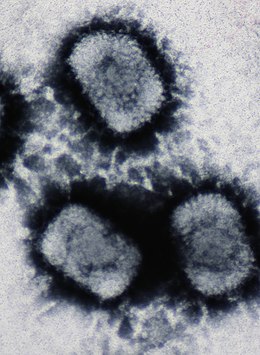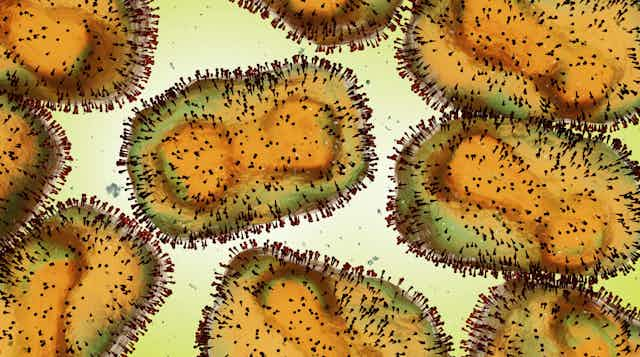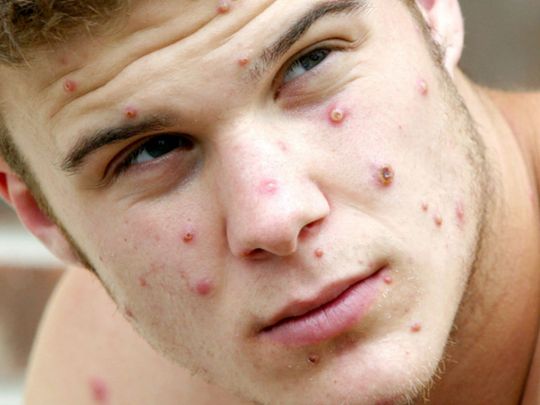Monkeypox virus (MPV or MPXV) is a double-stranded DNA virus that causes monkeypox in humans and other animals.
Thank you for reading this post, don't forget to subscribe!Symptoms of monkeypox are similar but less severe than those of the smallpox virus. They normally appear a week or two after exposure to the virus, though it can take longer in some cases.
Monkeypox normally starts with flu-like symptoms, including fever, chills, a headache, and achy muscles.
Unlike smallpox and chickenpox, swollen lymph nodes are also common. (Worth noting: Despite similar-sounding names and descriptions, chickenpox is caused by the varicella-zoster virus, meaning it is not related to the monkeypox virus.)
After 1 to 3 days of these symptoms, a rash usually develops on your face, then can spread to the rest of your body.
Next, the most notable symptoms can develop: flat, circular lesions in different parts of the body that eventually turn into bumps filled with a clear fluid.
These bumps eventually become crusty before falling off.
Monkeypox is largely transmitted through close, skin-to-skin contact with people who have lesions as a result of the virus.
Monkeypox Family
Monkeypox virus belongs to the genus Orthopoxvirus (Orthopoxvirus is a genus of viruses in the family Poxviridae and subfamily Chordopoxvirinae, vertebrates, including mammals and humans, and arthropods serve as natural hosts) in the family Poxviridae (Poxviridae is a family of viruses. Vertebrates, and arthropods serve as natural hosts. Diseases associated with this family include smallpox).
It is one of the human orthopoxviruses that includes variola (Smallpox was an infectious disease caused by one of two virus variants, Variola major and Variola minor).
The agent of variola virus (VARV) belongs to the genus Orthopoxvirus, the last naturally occurring case was diagnosed in October 1977, and the World Health Organization (WHO) certified the global eradication of the disease in 1980.).
Cowpox (CPX- Cowpox is an infectious disease caused by the cowpox virus (CPXV). The virus, part of the genus Orthopoxvirus, is closely related to the vaccinia virus {Vaccinia virus (VACV or VV) is a large, complex, enveloped virus belonging to the poxvirus family, The vaccinia virus is the source of the modern smallpox vaccine, Although smallpox no longer exists in the wild, vaccinia virus is still studied widely by scientists as a tool for gene therapy and genetic engineering}.
The virus is zoonotic (meaning transferable between species, such as from cat to human), and vaccinia (VACV) viruses. It is not a direct ancestor to, nor a direct descendant of, the variola virus, which causes smallpox.
Monkeypox disease is similar to smallpox, but with a milder rash and lower mortality rate.
Variation in virulence of the virus has been observed in isolates from Central Africa, where strains are more virulent than those from Western Africa. The two areas have distinct clades of the virus, termed Congo Basin (Central African) and West African clades.
Double-stranded DNA viruses

The first Baltimore group of DNA viruses are those that have a double-stranded DNA genome. All dsDNA viruses have their mRNA synthesized in a three-step process.
First, a transcription preinitiation complex binds to the DNA upstream of the site where transcription begins, allowing for the recruitment of a host RNA polymerase.
Second, once the RNA polymerase is recruited, it uses the negative strand as a template for synthesizing mRNA strands.
Third, the RNA polymerase terminates transcription upon reaching a specific signal, such as a polyadenylation site.
dsDNA viruses can be subdivided between those that replicate in the cell nucleus, and as such are relatively dependent on host cell machinery for transcription and replication, and those that replicate in the cytoplasm, in which case they have evolved or acquired their own means of executing transcription and replication.

dsDNA viruses are also commonly divided between tailed dsDNA viruses, referring to members of the realm Duplodnaviria, usually the tailed bacteriophages of the order Caudovirales, and tailless or non-tailed dsDNA viruses of the realm Varidnaviria.
Reservoir of Monkeypox virus
Monkeypox is carried by animals including primates. It was first identified by Preben von Magnus in Copenhagen, Denmark, in 1958 in crab-eating macaque monkeys (Macaca fascicularis) being used as laboratory animals.
The 2003 and now the 2022 outbreak in the United States, United Kingdom some European countries, India and Thailand, is traced to prairie dogs infected from an imported Gambian pouched rat.
Transmission of Monkeypox virus
The virus can spread both from animal to human and from human to human. Infection from animal to human can occur via an animal bite or by direct contact with an infected animal’s bodily fluids.
The virus can spread from human to human by both droplet respiration and contact with fomites (touchable surfaces) from an infected person’s bodily fluids.
The incubation period is between 10 and 14 days. Prodromal symptoms include swelling of lymph nodes, muscle pain, headache, fever, prior to the emergence of the rash as mentioned above in detail.
Epidemiology
The primary route of infection is thought to be contact with the infected animals or their bodily fluids.
The fresh reported outbreak outside Africa occurred in 2022 in the Midwestern United States in Illinois, Indiana, and Wisconsin, with one occurrence in New Jersey; UK, France Thailand and India.
Till now no deaths occurred.
Allopathic way of treatment still has NO ANY TREAtMENT for Monkeypox.
Homeopathic Treatment for Monkeypox virus:
Aconitum Napellus
Amaurosis, Anger, Apoplexy, Asthma, Bronchitis, Catalepsy, Catheter fever, Chest affections, Chickenpox, Monkeypox, Smallpox, Enteritis, Erythema nodosum, Excitement, Eye affections, Face flushing. Fear and its effects.Glands swollen. Glossitis. Hodgkin’s disease. Hyperpyrexia. Influenza. Jaundice.
Measles, Miliaria, Mumps, Esophagus inflammation, Pleurisy, Puerperal fever. Purpura. Quinsy. Remittent fever. Roseola. Scarlatina. Shivering. Sleeplessness, Tetanus. Tetany. Thirst. Throat affections. Tongue/mouth affections,Traumatic fever.
Urethra, spasmodic stricture, Urethral fever. Urine, suppression of. Uterus prolapsus.
Vaccination side effects, Yawning. Yellow fever.
Bryonia Alba
Bryonia should be advise in first stag; Symptoms are: Aphthae. Apoplexy. Asthma. Bilious attack. Breast, inflamed. Bronchitis. Cancer, Chlorosis. Constipation. Consumption. Coryza. Cough.
Eczema. Enteric fever. Eruptions. Gastroenteritis. Haemorrhages. Hands, swollen. Headache. Heart inflammation. Influenza. Intermittent fevers. Jaundice. Joints, pain in. Lactation, Liver malfunctioning.
Lumbago. Measles, Monkeypox, Smallpox, Scarlatina, Pleurisy, Suppressed eruptions and there bad effects. Meningitis. Menstruation, vicarious. Miliaria. Milk fever. Myalgia. Nephritis. Nose-bleed. Peritonitis. Phlegmasia alba dolens. Pleurodynia.
Morning cough, Puerperal fever. Pyuria. Relapsing fever. Remittent fever. Rheumatism. Screaming. Side, pain in. Sleep, anxious dreams in. Spina bifida. Stiff-neck. Thirst. Tongue, coated. Toothache. Trachea, pain in. Vertigo. Waking, starts and screams on. Water-brash. Whooping-cough. Yellow fever.
Symptoms worse by movement/motion. The eruption is slow in coming to the surface.
Sulphur
Acne. Adenoids. Ague. Alcohol habit. Amaurosis. Amenorrhoea. Anaemia. Anus, prolapse of. Asthma. Atelectasis. Bed-sores. Biliousness. Boils. Brain, congestion of. Breasts, affections of. Bright’s disease. Bronchitis. Cataract. Catarrh. Chagres fever. Chancre. Cheloid. Chest, pains in. Chilblains. Chloasma. Climaxis, sufferings of. Cold. Constipation. Consumption. Corns. Cough. Crusta serpiginosa. Dental fistula. Diabetes. Diarrhoea. Dysentery. Dysmenorrhoea. Ear, affections of. Eczema.
Emaciation. Enuresis. Epilepsy. Eructations. Eruptions. Eyes, affections of. Faintness. Feet, burning; Perspiring. Fever. Freckles. Ganglion. Glands, affections of. Gleet. Globus hystericus. Gonorrhoea. Gout. Haemorrhoids. Headache. Head, rush of blood to. Herpes. Hip-joint disease. Hydrocele. Hydrocephalus. Hydrothorax. Hypochondriasis. Impotence. Influenza. Intermittents. Irritation. Itch. Jaundice. Laryngitis. Leucorrhoea. Lichen. Liver, derangement of. Lumbago. Lungs, affections of. Lupus. Mania. Measles. Memory, weak. Meningitis. Menstruation, disorders of. Miscarriage. Molluscum.
Nettle Rash. Neuralgia. Nipples, sore. Nose, bleeding of; inflammation of. Esophagus, constriction of. Ophthalmia, acute; scrofulous; rheumatic. Pelvic haematocele. Phimosis. Phlegmasia dolens. Peritonitis. Pleurisy. Pneumonia. Pregnancy, disorders of. Prostatorrhoea. Rectum, affections of. Rheumatic fever. Rheumatism, acute; chronic; gonorrhoeal. Ringworm. Sciatica. Self-abuse. Sinking. Skin, affections of. Sleep, disordered. Smell, illusions of. Spinal irritation. Spine, curvature of. Spleen, pain in. Startings. Stomatitis. Taste, illusions of. Tenesmus. Thirst. Throat, mucus in. Tongue, coated. Tonsillitis. Toothache. Trachea, irritation in. Ulcers. Urticaria. Uterus, prolapse of. Vaccination. Varicocele. Varicosis. Vertigo. Warts. White swelling. Worms. Worry. Yawning.
Apis Melifistida
Abscess, Apoplexy. Asthma. Bladder affections, Carbuncle, Chancre, Dissection wounds. Dropsy. Erysipelas. Erythema nodosum. Eyes affections; optic neuritis.
Feet burning. Gangrene. Hands swelling. Heart affections. Heat-spots. Hydrocephalus. Hydrothorax. Injuries. Intermittent fever. Irritation.
Kidney: Bright’s disease. Labial inflammation, Ovaries pain, ovarian inflammation. Laryngitis. Lichen. Meningitis. Menstruation, derangements of. Nettle-rash.
Nose redness. Operations, effects of. ; tumours of. Panaritium. Pannus. Peritonitis. Phlebitis. Pleurisy. Prostatitis.
Punctured wounds. Scarlatina, Monkeypox, Smallpox. Self-abuse. Suppressed eruptions and their effects. Sycosis. Syphilis. Throat, sore. Tongue, oedema of; ulceration of. Trachea, irritation of. Tumours. Typhus. Urethritis. Vaccination. Varicose veins. Variola. Wounds.
Antimonium Tartaricum
Similarity of the smallpox pustule to those produced by Tartar emetic (Monkeypox). Hughes recognizes it almost as a routine agent.
With this remedy vesication and pustulation are marked.
Asphyxia neonatorum. Asthma. Bilious affections. Bronchitis. Catarrh. Chickenpox, Smallpox, Monkeypox. Cholera morbus. Coccygodynia. Cough. Group. Delirium-Tremens. Dyspepsia. Ecthyma. Eyes, inflamed. Impetigo. Intermittent fever. Laryngitis.
Lumbago. Myalgia. Paralysis agitans. Plica-polonica. Psoriasis. Rheumatism. Ringworm. Screaming. Stiff-neck. Sycosis. Synovitis. Taste, altered. Thirst. Tongue, coated. Tremors. Varioloid. Vomiting. Whooping-cough.
Thuja Occidentalis
Boenninghausen employed this remedy with success and believed it to be the best curative and preventive agent in smallpox, Monkeypox and Chickenpox.
It suits especially the eruptive stage, with milky, flat, painful and offensive pustules upon a dark inflamed area. Variola.
Variolinum
Asthma. Backache. Chill. Fever. Headache; occipital. Herpes zoster. Neuralgia. Smallpox, Monkeypox. Testicle, swelling, backache of smallpox. Neuralgia left by herpes. Side effects of vaccination, Severe cold; chill, violent fever with extremely hot skin, Pain in epigastrium. Pain in limbs as if in bones. Severe backache, pustules. Terrible ulcers on the skin.
Exanthema of sharp, pointed pimples, usually small, seldom large and suppurating, dry, resting on small red areolae, frequently interspersed with spots of red colour, sometimes severe itching. Petechial eruptions. Shingles.
Vaccinum 30 has been extensively used and with much benefit.
For profilaction variolinum-6x is proven by Dr. Burnett.
For treatment 1M or higher Dr. Qaisar Ahmed MD, DHMS.
Note: Never advise Variolinum to the patients with weak immune system especially in lower potencies.
Dr. Qaisar Ahmed MD, DHMS, Is. Jurisprudence.
Arsenicum Album
Desquamation of the skin of the body. Skin dry as parchment, cold and bluish. Yellowish/pale skin.-Shootings, hot itching, and violent burning in the skin. Reddish or bluish spots in the skin. Petechiae. Inflamed spots, as from morbilli, chiefly in the head, face, and neck.
Miliary eruptions, red and white. Conical pimples, whitish or reddish, with burning itching. Nettle Rash. Eruption of painful black pustules, sometimes itchy pimples, small and tickling. Eruption of small red pimples, which increase and change into gnawing ulcers, covered with a scurf. Vesicular eruptions.
Herpes, with vesicles, and violently burning, especially at night, or with coverings, like fish-scales. Skin jaundiced; general anasarca; black blisters. Pustules filled with blood and pus. Tettery spots, covered with phlyctenules and furfur, with burning nocturnal pains.
Ulcers with raised and hard edges, surrounded by a red and shining crown; with the bottoms like lard, or of a blackish-blue colour, with burning pains or shooting, principally when the parts affected become cold. Ulcers, hard on the edges, stinging, burning spongy; with proud flesh; turning black; flat; pus thin, ichorous (cancers), Fetid smell, ichorous suppuration, ready bleeding, putridity, and bluish or greenish colour of the ulcers.
Thin crusts or proud flesh on the ulcers. Spacelus. Want of secretion in the ulcers. Carbuncles (burning). Inflammatory tumours with burning pains. Warts. Ulcers inform of a wart. Chilblains. Varices. Discoloured nails.
Lachesis
Ecchymosis; wounds and ulcers bleed readily and copiously (small wounds bleed a good deal; ulcers bleed readily; cicatrices bleed readily; pain in old cicatrices), wounds bleeding a great while; skin very hard to heal, masses of blood pass through the pores.
Varicose swellings. Dropsical swelling over whole body. Hard and pale tumefaction. Skin yellow, green, lead-coloured, or bluish-red or blackish, chiefly round the wounds and ulcers. Yellow, red, copper-coloured spots. Pale, livid spots, with fainting fits. Dry, miliary itch, with eruption of large vesicles of a yellow or of a bluish-black colour, with swelling of parts affected, and pains which drive to despair.
Miliary eruption, which subsequently resembles nettle-rash, scarlatina, or morbilli. Erysipelas and vesicular eruptions with a red crown. Excoriated places, on touching which a burning pain is felt. Rupia and other skin affections, with angioleucitis (Cooper).
Ulcers, surrounded by pimples, vesicles, and other small ulcers (on a purple skin). Ulcers with great sensitiveness to touch, uneven bottom, ichorous, offensive discharge when touched, especially around the lower extremities.
Gangrenous ulcers. Gangrenous blisters. Superficial ulcers, foul at bottom, with a red crown. Cancerous ulceration (of wounds), or putrefaction of the flesh, which becomes detached from the bones, and falls off piecemeal. Gangrenous wounds, with inflammatory fever, weak, quick, and intermittent pulse, fainting nausea, spasmodic and bilious vomiting, convulsions, and cold sweats. Papulae, warts, hard swellings.
Panaris. Red and itching lumps and tuberosities. Carbuncles, with copper-coloured surroundings and many smaller boils around them. Flat exanthemata which do not fill up; pustulous exanthemata; spongy excrescences.
Crotalus Horridus
Swelling and discoloration, skin tense and shows every tint of color, with excruciating pain. Vesication. Sallow. Yellow color of the whole body. Great sensitiveness of skin of right half of body. Purpura haemorrhagica. Haemorrhage from every part of body. Bloody sweat. Chilblains, felons. Dissecting wounds. Pustular eruptions. Insect stings. Post-vaccination eruptions. Bad effects of vaccination. Lymphangitis and septicaemia. Boils, carbuncles, and eruptions are surrounded by purplish, mottled skin and oedema. Anthrax. Sore sensation relieved by pressure.
Lachesis
Hot perspiration, bluish, purplish appearance. Boils, carbuncles, ulcers, with bluish, purple surroundings. Dark blisters. Bed-sores, with black edges. Blue-black swellings. Pyemia; dissecting wounds. Purpura, with intense prostration. Senile erysipelas. Wens. Cellulitis. Varicose ulcers.
Baptisia
Great burning and heat in skin; Livid spots over body and limbs. Eruption like measles or urticaria. Confluent smallpox, Monkeypox, tardy eruption. Foul, gangrenous, eating syphilitic sores.
Anacardium Orientale
Intense itching, eczema, with mental irritability; vesicular eruption; swelling, urticaria; eruption like that of Poison-Oak (Xerophyl; Grindel; Croton). Lichen planus; neurotic eczema. Warts on hands. Ulcer formation on forearm.
Sarracenia
Polyctenid herpes. Psoriasis. Scrofulous eruptions.-Variola; (the decoction taken when eruption is out and beginning to pustulate aborts secondary fever and prevents pitting).
Eruption out, pustules dissipate, first on face, fever lessens, urine though scanty and dark becomes abundant and pale, strength returns. Eruptions similar to crusta lactea; on forehead and hands papular eruptions, changing to vesicular, with the depression as in small-pox lasting from seven to eight days.
P. S : This article is only for doctors having good knowledge about Homeopathy and allopathy, for learning purpose(s).
For proper consultation and treatment, please visit our clinic.
Location, address and contact numbers are given below.
NoN of above mentioned medicine(s) is/are not the full/complete treatment, but just hints for treatment; every patient has his own constitutional medicine along with these mentioned above.
To order medicine by courier, please send your details at WhatsApp– +923119884588
 Dr. Sayyad Qaisar Ahmed (MD {Ukraine}, DHMS) ; senior research officer Dnepropetrovsk state medical academy Ukraine; is a leading Homeopathic physician practicing in Al-Haytham clinic, Umer Farooq Chowk Risalpur Sadder (0923631023, 03119884588), K.P.K, Pakistan.
Dr. Sayyad Qaisar Ahmed (MD {Ukraine}, DHMS) ; senior research officer Dnepropetrovsk state medical academy Ukraine; is a leading Homeopathic physician practicing in Al-Haytham clinic, Umer Farooq Chowk Risalpur Sadder (0923631023, 03119884588), K.P.K, Pakistan.
Find more about Dr. Sayyad Qaisar Ahmed at :
https://www.youtube.com/Dr Qaisar Ahmed
https://www.facebook.com/dr.qaisar.dixecosmetics

Comments are closed.